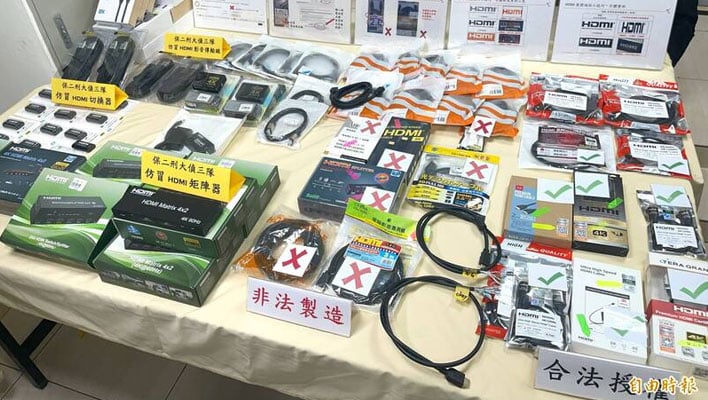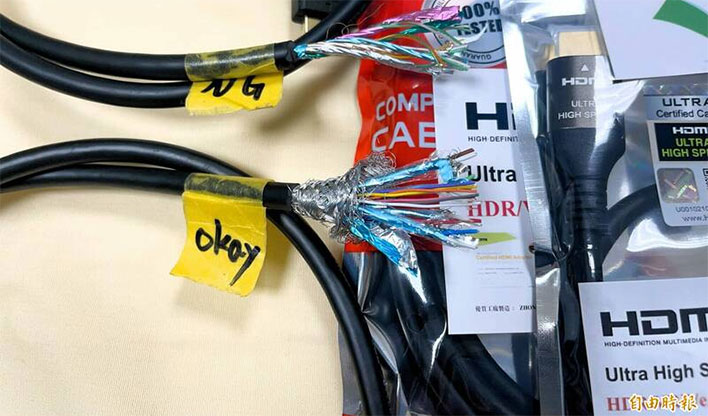Beware Of Counterfeit HDMI Cables As Authorities Seize $2.6M In Fake Knockoffs

You don't actually need to a spend a fortune on cables, whether it's an Ethernet cord or an HDMI cable for your television or PC monitor. However, you are well-advised to be on the lookout for counterfeit products. Driving this point home, police officials in Taiwan recently seized thousands of counterfeit HDMI cables purportedly worth in the neighborhood of 81 million Taiwan Dollars, or around $2.58 million in US currency.
Whether this was a nefarious operation is up for interpretation. A report by Taiwan's Public Television Service (PTS) characterized the individuals responsible as "unscrupulous operators," though local authorities were not as critical. According to Liberty Times Net, Xu Minchang, captain of the Bao Er Criminal Brigade, noted that there is confusion over the HDMI trademark.
From Minchang's vantage point, it is often misunderstood by the general public, online sellers, and stores that HDMI is an actual trademark and not just a name of a cable associated with audio and video transmissions. In order to apply the HDMI label to a product and then sell it, manufacturers must pay a fee and obtain authorization.
That's probably where the massive stated value of the cables comes into play. The figure may also include legal fees, damages, and who knows what else. Otherwise, it seems like a highly inflated sum for what amounts to 3,037 seized cables.
Article 97 of China's trademark law allows for counterfeiters to receive a prison sentence of up to one year or a fine of up to 50,000 Taiwan Dollars if they knowingly sell or possess, display, import, or export fake goods with an intent to sell. In this instance, the cables were being sold on Shopee, an online platform. Authorities arrested three individuals as part of a long-term investigation.

Source: Liberty Times Net
Regardless of whether a cable is knowingly sold as counterfeit or not, buyers should do their due diligence before making a purchase. Cheap knockoffs can cut corners. In the image above, the knockoff cable on top has fewer lines than the genuine cable on the bottom, which can negatively affect image quality and performance.
Ji Jianting, HDMI Asia Pacific Copyright Manger, told Liberty Times Net that an HDMI cable for use with TVs should have 19 lines inside, as well as an insulating ring. Some counterfeit cables cut out six or nine lines and lack an insulator. In doing so, a cable that touts 8K compatibility may only be able to support 720p images, Jianting says. He also says it increases the risk of a short circuit, which could damage equipment.
So, how do you avoid a fake knockoff? There are signs to look for. One of them is the font—the HDMI trademark font uses three colors only (black, white, and gray). Additionally, genuine HDMI cable packages do not list the version number separately, so if its says 2.1, 2.0, or 1.4, it is fake.
One of the best measures is to look for a QR code on the package and use HDMI's free app to scan it (download for Android or iOS).
Scanning is not really an option if buying online, only after the fact, at least on the physical product (as opposed to a picture on the listing). As such, stick with reputable vendors with good return policies, and avoid marketplace sellers unless they're also reputable. Here are some options on Amazon...
- Monoprice Premium (6-ft, 18Gbps): $5.98 (54% off)
- Monoprice Ultra 8K Premium (8-ft, 48Gbps): $7.89 (12% off)
- Cable Matters Ultra High Speed 3-Pack (6.6-ft, 48Gbps): $21.95 (12% off + 5% off coupon)
- Amazon Basics (6-ft, 48Gbps): $9.49
- Anker (10-ft, 48Gbps): $20.99 + 20% coupon
- Monster Cobalt 2-Pack (2-ft, 48Gbps): $24.99
Top Image Source: Liberty Times Net

